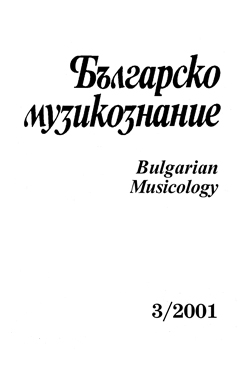Исон-практиката в църковната музика на източноправославния Балкански регион: Идеята за многогласие
Ison-Practice in the Eastern Ecclesiastical Chant of the Orthodox Balkan Region - Idea of Polyphony
Author(s): Elena TonchevaSubject(s): Music
Published by: Институт за изследване на изкуствата, Българска академия на науките
Summary/Abstract: In musical science polyphony. has been emphasized repeatedly as a phenomenon characteristic for the Western European musical development, differentiating it from the Orthodox tradition of Eastern Europe during the Middle Ages. The article makes an attempt to follow manifestations of polyphony in the ecclesiastical music in the Orthodox Balkan region on the basis of written musical sources. “The Ison drone” /dron diaphony/ characteristic for the region is presented according to observations on modern ecclesiastical chanting practice /by authorities on ecclesiastical chanting such as prof. Gregorius Stathis and the protopsaltes of the Bulgarian Church Peter Dinev/. Data on Ison-chanting from neumed sources from XIV century are followed: appearance of the direction “vastakton” in kalophonic chants /according to the manuscript Athens No.2422 the use of this direction in Polyeleos cycle is described by Koukoumas/, pointing out that possibly this direction for Ison-dronning is conncected with the tendency for increasing the festive brilliance of the chant /in complex musical “full score”/ - a function parallel to the function of Polyphony in its early appearance in the Western European ecclesiastical music in IX century. But the Ison-diaphony on the Balkans does not receive further theoretical significance, it remains traditional and is not expressed in the written musical sources. An attempt is made in the article to derive new information about the Ison chanting in the Middle Ages on the basis of the late Byzantine neume classification and the position of the neume sign “Ison” /meaning repetition of the preceding tone/ in it; the definitions of the sign introduced into the treatise papadikai are interpreted. In this respect the principal characteristic feature of the Balkan Orthodox musical-theoretical terminology in the late Byzantine period is emphasized /XIV - XV c./: its close connection with theology /in the neume classifications are introduced concepts related to basic theological ideas - e. g. signs “bodies” (Somata) and “spirits” (Pneumata), signs “hypostaseis”/. The theological meaning of the connection between the sign “ison” and the Orthodox doctrine of the Holy Trinity is emphasized /according to a treatise by Michael Blemmydes from XIII c./. Thus the hypothesis is supported that the theological meaning of the ecclesiastical music characteristic for the Orthodox church, which remains “music-cult” NI. Loskii/ until the Balkan Revival in XIX century, preserves the Ison-diaphony and does not let it develop. It is accepted that the symbolism of the sign “ison” also determines the aesthetics of the performance of the droning sound Ison. The article is dedicated to the 70th anniversary of prof. Dr. Constantin Floros.
Journal: Българско музикознание
- Issue Year: 2001
- Issue No: 3
- Page Range: 3-13
- Page Count: 11
- Content File-PDF

